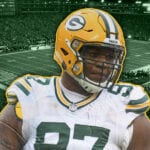The NFL has a major problem on its hands regarding the quarterback position and that is the number of teams needing them and a vicious lack of options in the 2017 offseason. Most of the veteran commodities are either unproven or have been disappointments over the past few seasons. In the draft, there is no player consistently ranked the top quarterback and Deshone Kizer, Deshaun Watson and Mitch Trubisky have all shared the honor at different times.
However, there is a player slowly creeping up draft boards and finally getting the recognition he deserves in the scouting community. Texas Tech’s Patrick Mahomes II gave up his final year of college eligibility after a strong 2016 season in the Big 12 Conference. Mahomes won the Sammy Baugh Trophy and tied the NCAA record for passing yards in a single game with 734 against Oklahoma. The young gunslinger threw 41 touchdowns and over 5,000 yards in 12 2016 performances and dramatically raised his stock in the process.
Mahomes has an opportunity to pull ahead of the proverbial pack over the next two months, especially with more and more national pundits giving him rave reviews. The 21-year-old has an intriguing skill set that made him a legendary Red Raider and could do the same thing in the National Football League.
Positives:
To put it plainly, there is a lot to like about Patrick Mahomes and he’s definitely one of the most naturally talented passers in this draft class. Physically, Mahomes passes the eye test at 6’3 and over 230 pounds and he inherited his arm talent from his father, who played professional baseball for over a decade. The younger Mahomes doesn’t have the strongest arm in this class, but it’s still one of the most impressive and he utilizes it more often than any other draft eligible signal caller. The only quarterbacks that may make more NFL throws are Pittsburgh’s Nathan Peterman and Mahomes’ former teammate, Cal’s Davis Webb.

While both of the aforementioned quarterbacks have a chance to be selected on the second day of the draft, they lack a number of other traits Mahomes possesses, including the physical ability. The former Red Raider developed under one of the brightest coaching stars at any level of football, Kliff Kingsbury, who played under Bill Belichick with the New England Patriots and worked with Tom Brady for a season (he was also a Sammy Baugh Trophy winner like his protege). Under Kingsbury, Mahomes progressed each season, cutting down on turnovers and increasing his yardage, completion percentage, touchdown passes and touchdown to interception ratio.
Looking past his numbers, Mahomes excels not just at putting up eye-popping stats, but looking like a legitimate threat while doing it. Having a Donovan McNabb-esque build and projected sub-4.6 speed, he is able to brush off defenders, stay alive in the pocket, or use his excellent athleticism to throw on the run or pick up yards himself. Combining this ability to move around the pocket with his arm strength and deep accuracy, there is no such thing as a broken play in his arsenal. The only real questions about Mahomes is how long it will take him to be ready to play at the next level.
Texas Tech may have a non-conventional offense that doesn’t translate to the NFL, but Mahomes mastered it as well as Derek Carr did with a similar system at Fresno State. Carr fell to the second round of the 2014 NFL Draft mostly because of the offense he played in, but he has become one of the best quarterbacks in the league just a few seasons into his career. While Mahomes didn’t start as many games as Carr, he was very close and had a similar amount of steady improvement over his starts as well. Where Mahomes has Carr beat, though, is in arm talent, pocket awareness and size. Both players are very similar, and the same kind of development time should be expected for Mahomes as Carr had with the Oakland Raiders (with perhaps more rough patches in the beginning for Mahomes).
Mahomes dominates throwing mid range passes on timing routes, which does translate to the next level. Tom Brady has thrived in that sort of offense the past couple of seasons, and while Texas Tech is in no way similar to the New England Patriots, it’s interesting that a player coached by one of Tom Brady’s teammates excels in a similar way. The rest is very standard in Mahomes’ favor– solid release, makes quick decisions on the fly and doesn’t throw boneheaded interceptions (even though he does throw a high number of interceptions), top notch character with absolutely no issues or off-field drama, and comes from a family used to the professional sports world.
Negatives:
Not everything is positive about Mahomes, and that’s evident from the national consensus that he’s likely a second round pick this coming April. The main issue, outside of the offense he plays in, is his gunslinger mentality. Mahomes has thrown 25 interceptions over the past two years, and while he improved quite a bit in his final season in Lubbock, Texas, he still threw double digit interceptions two consecutive seasons. Many times, he trusts his arm too much on the interceptions he throws and it can put his team in a bad situation.

Mahomes had a stretch of six straight games where he threw an interception in 2016 and Texas Tech went 2-4 in that span. Three of the four games were determined by one touchdown or less, which makes every turnover important in such a high octane offense. The Big 12 also is known for having weak defenses, so any turnover can be a huge issues at Texas Tech. He’s going to have to learn how to protect the football better without losing the aggressiveness that makes him such a special player. NFL quarterbacks cannot rely on their defenses to bail them out of trouble with how quickly teams can run away with momentum. In the two games where he threw multiple interceptions, Texas Tech gave up 68 and 66 points respectively.
The interceptions point to another issue and that is consistency. While Mahomes is improving, and that can’t be stressed enough, he was still inconsistent at times in 2016. With two games under a 60 percent completion rate, Mahomes improved quite a bit in terms of consistent accuracy since he had twice as many such games the year before, but he still lost both of those games this past year. One of the low points was a 56 point loss to Iowa State when he only threw for 219 yards and completed half of his 36 pass attempts. This was also one of his multi-interception games, which shows that these two problems go hand in hand.
What has to be the elephant in the room is the offense Mahomes played in at Texas Tech. There are more and more quarterbacks coming from spread offenses, so this will become less of a point in future drafts, but it’s still worth noting because it’s getting harder to evaluate how a player will transition to the next level. He may not be able to start right away, which is another strike against him, but there may not be a single quarterback able to do that in this class. There is no Andrew Luck or Cam Newton in this year, so there are going to be major question marks for all of these players.
Conclusion:
Patrick Mahomes II is a first round talent, and while he has issues that may end up extending his development time, he has more talent than most players currently being mentioned ahead of him. The arm talent Mahomes exhibits is top notch and he backs it up with his athleticism and on-field maturity. Unlike players like Watson, Trubisky, and Kizer, Mahomes would be a high pick in every class and isn’t a product of one of the more disappointing classes in recent memory. Conventional wisdom says he should be drafted ahead of these other players and that should be the case.
Last season, Carson Wentz moved up from a second or third round pick into the second pick in the draft after the 2015 season ended. The same type of rise could happen here if a team is willing to look past an offensive system that is becoming commonplace in college football. Mahomes could push for that kind of jump with a strong combine and if the Texas Tech star can prove to a team that he’s ready to eliminate the turnovers and adjust to a complex NFL system.
For more from Ryan Bonds, follow him on Twitter @Bonds_NFL








